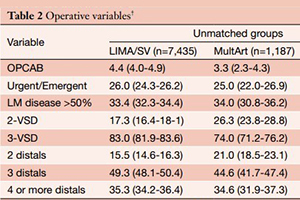Improved late survival with arterial revascularization
Abstract
New coronary artery revascularization strategies are developing: improved quantification of coronary artery disease by the SYNTAX score, new-generation drug-eluting stents and increased use of stents for multivessel disease, ongoing evaluation of stents for left main disease, new strategies for minimally invasive coronary artery bypass grafting (CABG) including the use of robotic-assisted CABG, hybrid procedures, and off pump CABG. In comparisons of all these strategies, the impact on survival is arguably the most important parameter. It has long been accepted that using the left internal mammary artery (LIMA) to bypass the left anterior descending coronary artery (LAD) is the gold standard and may confer the survival advantage reported for CABG compared with percutaneous coronary intervention in the literature. The survival advantage of using additional arterial conduits as compared to the conventional use of LIMA with saphenous veins only has long been debated. Our study, which involved a large cohort of 8,622 patients with multivessel disease, followed over a long period of time, has shown that in primary isolated CABG surgery performed more than 15 years ago with the use of LIMA to the LAD, bypassing the non-LAD targets with at least 1 additional arterial graft, either the right internal mammary artery and/or the radial artery, was an independent predictor of increased survival during the following 15 years. The results were confirmed with both a propensity-matched analysis that included 1,153 patients in each group and a multivariate analysis that was able to control for all differences between the groups because of the power of the large cohort in this series. The significant survival advantage of coronary artery bypass surgery with the use of multiple arterial grafting cannot be ignored in patients with multivessel coronary artery disease as various revascularization strategies are considered.
Cover






